Whether your inspiration is Project Runway or a quilting convention, you need the best sewing machine for beginners to get started. Not only is sewing a useful and fun hobby, but it will provide you an outlet for your creativity, as well as potentially saving you a good deal of money in the long run.
It’s important to have the right equipment because learning this fun and simple skill can quickly turn into a nightmare with an overly complicated or impractically designed machine. We have personally researched the most popular models on the market so that you can choose the best basic sewing machine for your needs.
See The Quick Comparison Chart
Are You Planning to Start Sewing?
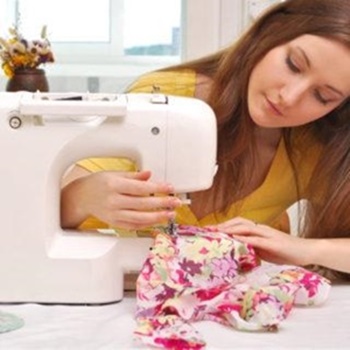 Once you know how to sew, an entirely new world is open to you. It’s not just about learning to create amazing clothing and decor from scratch. You can even use it for simple, practical purposes, such as mending things. Why pay someone else, when you can easily fix the damage and preserve your beloved clothes in a matter of minutes.
Once you know how to sew, an entirely new world is open to you. It’s not just about learning to create amazing clothing and decor from scratch. You can even use it for simple, practical purposes, such as mending things. Why pay someone else, when you can easily fix the damage and preserve your beloved clothes in a matter of minutes.
Mend and skillfully patch your torn favorites, and you’ll save a lot of money on alterations, or buying entirely new things. You can use it for other small projects, such as adding trim or your own personal touch to things you already own.
Add velvet trim to a collar of a wool coat, or bright satin ribbon to the hem of a plain dress. Add a footer of brocade or taffeta to plain curtains for a chic effect. Your home and your wardrobe will shine with the reflection of your personal tastes. Bring your vision to life, whether it’s an entirely new design or a children’s school project.
1. Pattern Selection
Whether it’s for dresses, dolls, or pillows, you may have already chosen a pattern for the project you want to try. If you haven’t, or if it is a project of high difficulty and you want to try something simpler first, fabric shops usually have a catalog of patterns of all kinds, ranked in order of ease, and you can tell before you pick one how difficult it will be.
2. Fabrics
Different kinds of fabrics have different levels of difficulty for sewing, and not just because of their thickness. Sometimes, as with chiffon, it’s the opposite, and you have to be very particular about your needles and thread types, as well as use extra steps, such as staystitching (a line of stitches on a single layer, which prevents stretching). Slippery fabrics like satin can also be difficult to tackle right away. Some fabrics can bunch up or pucker if they are not fed through correctly or held firm.
Before beginning any sewing projects, make sure that you prewash your fabric! This ensures the work of carefully cutting patterns to size is not entirely wasted. It also prevents the dye from a new fabric staining everything else in your laundry load. A good rule of thumb is to always follow washing instructions for your fabric.
3. Thread
As we said before, different types of threads are good for different purposes. Cotton thread is more expensive than polyester, but polyester tends to tangle more easily. Quilting thread is very strong and can cut you if you try to break it by hand. It would be best to have those thread scissors nearby.
With today’s machines, sewing is a relatively simple skill to begin cultivating if you understand the basic purposes of the machine’s parts. These are easy to learn about. The essential framework of a sewing machine’s structure is two spinning rods driven by a single belt. The top rod arm drives the needle up and down, and the bottom one drives the bobbin.
Should You Start With a Basic or More Advanced Sewing Machine?
While it does make more sense to invest in a stronger and more advanced model right from the start, we always advise that beginners start with beginner sewing machine models. Having too many options, in the beginning, can be quite frightening – you might be so overwhelmed that you wouldn’t want to continue learning how to sew.
Chances are you wouldn’t need the advanced stitches for a long time. Many professionals use just basic stitches throughout their work. Depending on your projects, you might not need the decorative stitches ever. Master the basics first and then choose the more advanced model that will suit your needs – because after a while you will exactly know what those needs are.
Best Beginner Sewing Machines Comparison Chart
| PRODUCT | DETAILS | ||
|---|---|---|---|
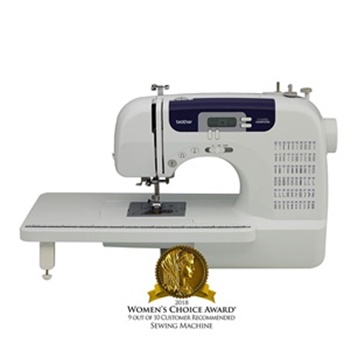 | Brother CS6000i |
| View On Amazon |
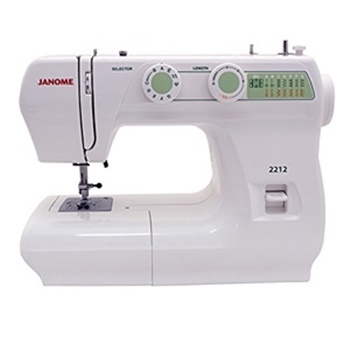 | Janome 2212 |
| View On Amazon |
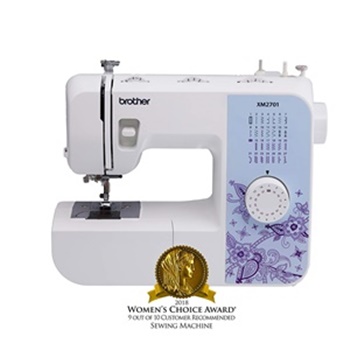 | Brother XM2701 |
| View On Amazon |
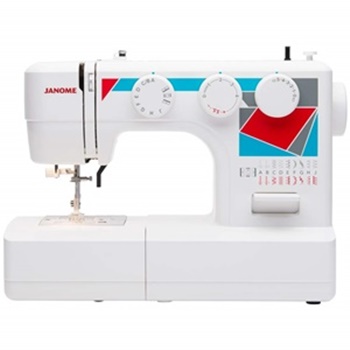 | Janome MOD-19 |
| View On Amazon |
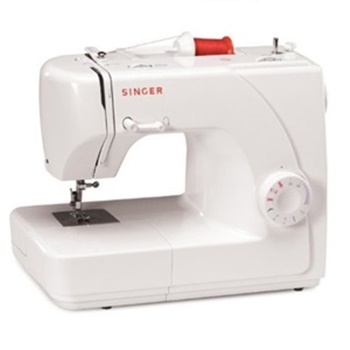 | Singer 1507WC |
| View On Amazon |
Best Sewing Machine For Beginners Reviews
1. Brother CS6000i
 If you are new to sewing, or your sewing needs are quite simple, it’s a good idea to invest in a beginner sewing machine. Brother CS6000i comes with a wide table perfect for large quilting projects. When it comes to additional features, the thing that makes this machine user-friendly the most is its intuitive LCD display.
If you are new to sewing, or your sewing needs are quite simple, it’s a good idea to invest in a beginner sewing machine. Brother CS6000i comes with a wide table perfect for large quilting projects. When it comes to additional features, the thing that makes this machine user-friendly the most is its intuitive LCD display.
Also, there is no need to squint anymore when threading the needle because this unit has an automatic needle threader that does everything for you. Your eyes will also be thankful because the work area is lit. That is great for working on dark fabrics.
Read More: Brother CS6000i
2. Janome 2212
 This machine is good for beginners and simple projects. The affordable price makes it even more appealing, and when you add a bonus bundle to the mix, it’s clear to see why many will become proud owners of this sewing machine.
This machine is good for beginners and simple projects. The affordable price makes it even more appealing, and when you add a bonus bundle to the mix, it’s clear to see why many will become proud owners of this sewing machine.
There are 12 built-in variations of stitches, plus there’s an automated buttonhole feature.
This machine works well through layers and thick fabrics, so you can easily complete a variety of projects and even sew denim. There is also a free-arm feature and a drop feed, which you can use for free-style sewing.
This sewing machine is very portable – it’s only 15 lbs., including the shipping weight. This unit is considered to be medium to light duty in the range for machines in its class. If you order a unit with a bonus bundle, you will get a pack of 10 bobbins, as well as size 14 sewing needles. These are good for general purposes, but for fine or delicate fabrics, you may need a smaller needle size.
Janome is one of the most popular and well-known brands, and they offer 25 years of warranty for this model. They have online and telephone support available, and no shortage of authorized dealers in North America.
Read More: Janome 2212
3. Brother XM2701
 This petite machine with an elegant blue paisley motif on the exterior proved to be very popular and useful among beginners. This machine has 27 different stitching configurations and has an easy to set stitch length dial on the top. It also comes with 6 different presser feet, including the ones for buttons, buttonholes, zippers, and zigzags.
This petite machine with an elegant blue paisley motif on the exterior proved to be very popular and useful among beginners. This machine has 27 different stitching configurations and has an easy to set stitch length dial on the top. It also comes with 6 different presser feet, including the ones for buttons, buttonholes, zippers, and zigzags.
The top-loading bobbin lets you change it quickly and with ease, and also – it tangles less. The automatic needle threader will be very helpful because you won’t have to push the thread through the needle on your own. The reverse sewing setting can also be tricky at times for beginners, but you can quickly get the hang of it. This unit weighs just over 12.6 lbs. which means it’s portable.
Brother is one of the top most popular brands of sewing machine manufacturers in North America. They have accessible customer service support online, and via telephone, but their service hours are limited from 9 AM to 6 PM Eastern Time. This model comes with 25 years of limited warranty. The company website also has a locator to find your closest authorized repair place and dealers.
Read More: Brother XM2701
4. Janome MOD-19
 This little machine has a stylish modern motif in bright colors, and its lightweight makes it very portable. At only 14 lbs., it’s a good portable model you can carry wherever you go, or easily move it around the house. Although you should pay attention when traveling, most sewing machines are too delicate for extensive travel and should not be checked as baggage in the airlines.
This little machine has a stylish modern motif in bright colors, and its lightweight makes it very portable. At only 14 lbs., it’s a good portable model you can carry wherever you go, or easily move it around the house. Although you should pay attention when traveling, most sewing machines are too delicate for extensive travel and should not be checked as baggage in the airlines.
This unit comes with 4 presser feet and 19 different stitch configurations. You can easily use the stitch width and length adjustment, as well as free arm and drop feed features for versatility. Most household projects will be a breeze, but this sewing machine can tackle some of the more complex tasks. This is still basic to a medium-level unit.
Janome is one of the most popular and well-known manufacturers of sewing machines. It’s a good mechanical machine, with no computerized features, which means it will probably serve you well without the need for too many repairs. There is an online and telephone support available, and there are plenty of authorized dealers in North America. This unit also comes with a 25-year limited warranty.
Read More: Janome MOD-19
5. Singer 1507WC
 This is a simpler machine, with only 8 different types of stitches, but it will get the basic jobs done nicely. That makes it perfect for beginner use when you are just learning the craft. One of the best features of this unit is that it has a fully automated 4-step buttonhole.
This is a simpler machine, with only 8 different types of stitches, but it will get the basic jobs done nicely. That makes it perfect for beginner use when you are just learning the craft. One of the best features of this unit is that it has a fully automated 4-step buttonhole.
When it comes to specifications, this beginner sewing machine has a built-in free arm for sewing curves and managing difficult spaces. The free arm is best used for sewing pant legs and sleeves. It will provide you hours of basic work, but with lightweight plastic parts, it is not built to withstand professional or constant use.
This unit has a rapid acceleration rate feature, and beginners might find this tricky to control at first. With a shipping weight of just under 16.5 lbs. and machine weight of 13 lbs., it is portable enough to go about the house. It’s also great if you need to take your own sewing machine to a workshop if you are taking classes. It has a nice canvas cover with a handle.
Their homepage offers a locator for retailers who sell their machines, but as far as their service, they offer a link to their Sheets in Google Drive, which provides a single long list of authorized repair people in every state. They also offer their email, telephone, and mailing contact information, and provide support from 8 a.m. to 8 p.m., Central time.
Read More: Singer 1507WC
6. Brother CS5055PRW
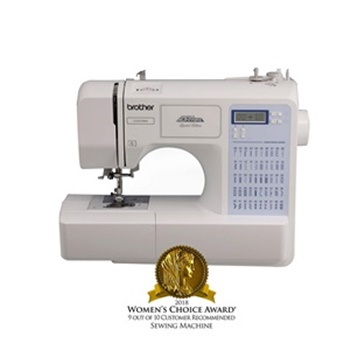 This model touts itself as the Project Runway model, created with the couture designer in focus: with 50 different stitch configurations (Including unique and decorative motifs), 6 presser feet (including one for monogramming), specialty needles, and 5 different buttonhole options, and a free arm for cuffs and trousers, and automatic needle threader. It weighs just under 15 lbs.
This model touts itself as the Project Runway model, created with the couture designer in focus: with 50 different stitch configurations (Including unique and decorative motifs), 6 presser feet (including one for monogramming), specialty needles, and 5 different buttonhole options, and a free arm for cuffs and trousers, and automatic needle threader. It weighs just under 15 lbs.
If you are getting into sewing for fashion or costuming’s sake, then this model is a good consideration. It has many bells and whistles for a beginner, but if you are a dedicated student, their features may inspire your projects. The only negative side was occasional jamming of fabric in the bobbin, but that is easily resolved.
Brother is one of the top brands in North America. They have accessible customer service support online, and via telephone, but their service hours are limited from 9 a.m. to 6 p.m. Eastern Time. The company website also has a locator to find your closest authorized repair place and dealers.
Read More: Brother CS5055PRW
7. SINGER Tradition 2277
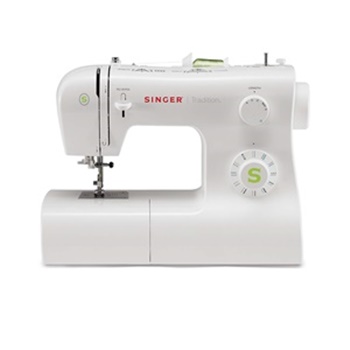 This model’s exterior maintains a slight curvature, as a nod to the history of the renowned brand’s design. It features 23 different stitch configurations and one buttonhole. There is also an automatic needle-threader and a free arm. Furthermore, it comes with 3 snap-on presser feet: a basic stitch, a buttonhole foot, and a button foot.
This model’s exterior maintains a slight curvature, as a nod to the history of the renowned brand’s design. It features 23 different stitch configurations and one buttonhole. There is also an automatic needle-threader and a free arm. Furthermore, it comes with 3 snap-on presser feet: a basic stitch, a buttonhole foot, and a button foot.
The metal frame gives it the strength to support your fashion projects and adds to the durability. Shipping weight is just over 16 lbs., and the machine itself weighs just 13.6 pounds. This is a machine can only be used in the United States and Canada, as it was made to be used with 110 volts of electricity.
Their homepage offers a finder feature for locations of retailers who sell their machines, but as far as service, they give a link to their Sheets in Google Drive, which provides a single long list of authorized repair shops in every state. They also offer their email, telephone, and email contact information, and provide support from 8 AM to 8 PM Central time.
Read More: SINGER Tradition 2277
8. Janome Arctic Crystal
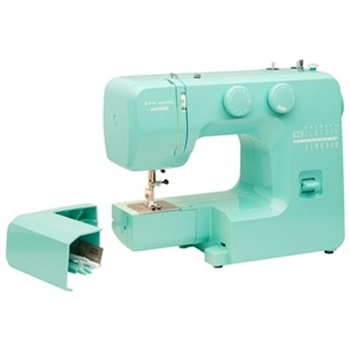 This model comes with a sturdy metal frame underneath its beautiful pale green exterior. The Crystal model only essentially differs in color from the Sorbet (pink) and the Couture (blue). This unit has 15 different types of stitches and one buttonhole option. It also comes with 4 presser feet: a general purpose foot, zipper foot, blind hemming foot, and a sliding buttonhole foot.
This model comes with a sturdy metal frame underneath its beautiful pale green exterior. The Crystal model only essentially differs in color from the Sorbet (pink) and the Couture (blue). This unit has 15 different types of stitches and one buttonhole option. It also comes with 4 presser feet: a general purpose foot, zipper foot, blind hemming foot, and a sliding buttonhole foot.
Its weight of just under 12 lbs. makes it a lightweight model in its class, very portable around the house. The bobbin loads in the front, and it also has easy-to-follow instructions inside. That will save you a lot of time you would spend searching for the info in the manual. If you get stuck, you can always consult their YouTube video tutorials.
This machine comes with a warranty and when it comes to customer support, Jarome has online and telephone support available. There are plenty of authorized dealers in North America that will accept it for repairs.
Read More: Janome Arctic Crystal
9. SINGER 4423
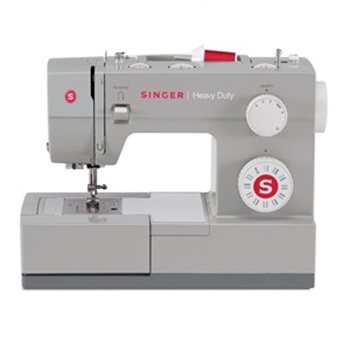 This hefty machine is made for heavy-duty work, with a strong motor and fast sewing speed, much faster when compared to the others in its class. It weighs 14.5 lbs., making it a bit sturdier than the ones on the list.
This hefty machine is made for heavy-duty work, with a strong motor and fast sewing speed, much faster when compared to the others in its class. It weighs 14.5 lbs., making it a bit sturdier than the ones on the list.
This model offers 23 types of stitches and 4 presser feet. With the correct needles, it can sew through leather and upholstery fabric. Like we already mentioned, this machine works fast – you can get 100 stitches per minute. Automatic needle threading will also help you finish your projects faster, and will save your eyes from squinting.
The downsides to this machine are that it has a tendency to entangle the bobbin, but many beginner machines have the same issue. Luckily, it’s easily fixed, you just need do detangle it. Also, it has no free arm option.
Their homepage offers a finder feature for locations of retailers who sell their machines, but as far as service, they give a link to their Sheets in Google Drive. There you can find a list of authorized repairmen in every state. You can also contact them through email, telephone, and mail. They provide customer support from 8 AM to 8 PM Central time.
Read More: Singer 4423
10. Spiegel SP3201 Sewing Machine
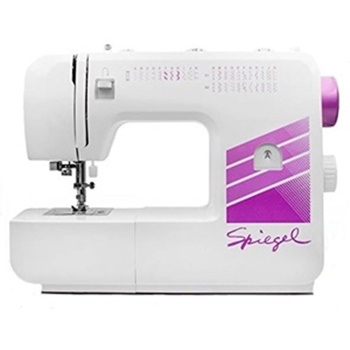 A mechanical sewing machine like this is always a good choice for a beginner because they don’t break as much, and are considered to be durable. This model is one of the most basic ones on our list, but it comes with a good price tag. For such an affordable unit, this Spiegel comes with plenty of additional features that will prove useful.
A mechanical sewing machine like this is always a good choice for a beginner because they don’t break as much, and are considered to be durable. This model is one of the most basic ones on our list, but it comes with a good price tag. For such an affordable unit, this Spiegel comes with plenty of additional features that will prove useful.
There are 32 utility and decorative stitches, which is more than enough for someone who is just starting to sew. This sewing machine comes with a top-loading bobbin and a one-step automatic buttonhole maker. You can easily adjust the thread tension, stitch length and width. If you are sewing late, there’s an LED light to keep your work area well lit.
But, that’s not all. This model also has the ability to lower the feed dogs, so you can easily start freehand sewing. This machine is very light, only 12 pounds, so you can easily lug it around and store it away when you don’t need it. When you buy this machine, you get access to Spiegel’s app with tutorials, including the ones for beginners. It comes with a 1-year warranty.
Read More: Spiegel SP3201
11. Janome 13512 Red Hello Kitty
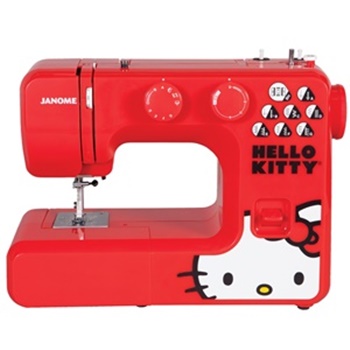 Sewing machines for kids have to be safe to use, but they can also be a useful tool for beginners just getting into the world of stitching. Janome 13512 is one of the most durable kid sewing machines on the market. It has 15 stitches, including the adjustable stitch length.
Sewing machines for kids have to be safe to use, but they can also be a useful tool for beginners just getting into the world of stitching. Janome 13512 is one of the most durable kid sewing machines on the market. It has 15 stitches, including the adjustable stitch length.
For a children’s sewing machine, this unit has some of the most modern functions. There is a vertical oscillating hook bobbin system, and also a left and center needle position. Made from aluminum, this sewing machine is very durable, and it can even support basic household sewing projects with ease.
Read More: Janome Hello Kitty
Sewing Terms to be Known
1. Needles
On a sewing machine, the needle is clamped into the machine with the eye on its tip. Different needles are required for different purposes and materials. Needles differ from one another by length and the shape. Needles have different numbers, and in the American system, we use needles 8, 9, 10, 11, 12, 14, 16, 18 and 19. The number 8 is the lightest needle, and 19 the heaviest. The thicker the fabric you have to penetrate, the heavier the needle has to be. Size 19 would easily drill massive holes in sheer curtain fabric, for example.
2. Feed Dogs
Feed dogs are small mechanisms on the plate which push the material through to the needle. You can find feed dogs on drop-feed sewing machines. Feed dogs move the fabric further, which also helps with straight sewing. If you want to do quilting, you have to turn off the feed dogs – drop them down.
You can check our quilting sewing machine reviews for details.
3. Presser foot/ feet
The presser foot holds the material down at the needle so that you can guide it evenly. There are different types of interchangeable feet for different jobs, such as for sewing zippers or buttons, and buttonholes. Presser feet, just like needles, are a changeable part of a machine. There are more than a dozen different types of presser feet for sewing.
4. Thread Spindle
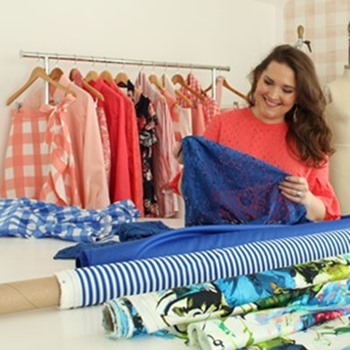 Thread spindle is the mounting place for your top spool of thread, and it’s an essential part of every sewing machine.
Thread spindle is the mounting place for your top spool of thread, and it’s an essential part of every sewing machine.
5. Bobbin
A bobbin holds the second or a bottom thread. The bobbin is mounted in a bobbin case below and is meant to spin in time with the top so the threads are sewn evenly through the fabric. There are vertical and horizontal bobbins.
6. Thread Guide
Thread guide is the path the thread takes from the spindle to the needle. It is also a mechanism that guides the thread when it needs to change direction.
7. Tension Control
There are devices that control the tension of the thread in the sewing machines. This is vital for sewing even stitches. That tension actually represents a tension between the upper and lower thread. The wrong tension can leave you with sloppy and loose stitches. Even the beginner sewing machines often have stitch tension control.
8. Stitch Type Selector
A stitch type selector is usually a knob, dial or a feature for setting the type of stitch you want. Basic machines have a limited number of stitches, but the advanced ones can even have more than 100! You have basic stitches, decorative stitches, hemstitches, buttonhole ones, and many others.
9. Stitch Width Selector
Stitch width selector is a knob or a feature for setting the width of your stitches. This is a space that your stitch will occupy horizontally. Adjusting this will also change the appearance of a stitch. Stitch width is the most important in zigzag stitches.
10. Stitch Length Selector
Stitch length selector is also a knob or dial that will help you set the length of your stitches. The length is the distance of the thread between needle punctures. Actually, it is the feature that lets the feed dogs know how much fabric to feed with each stitch. This feature will directly impact the quality of a stitch!
11. Foot Pedal
Many machines are powered by an electric foot pedal, which makes sewing much easier. You don’t have to take off your hands from the material, and you choose when to start and stop sewing with a simple foot gesture.
12. Hand Wheel
The wheel on the side of the machine for making manual adjustments to the needle’s position is called the handwheel, or the balance wheel. You will mostly use it to drop the needle down when you want to start a seam or to pull it up when you want to finish the seam. Make sure you move the wheel in the right direction, otherwise you might accidentally entangle the thread.
13. Accessories
Every sewing machine comes with a variation of accessories and attachments. The most basic of these should include the power pedal and cord (which are an essential part of the functioning machine), 4 or 5 basic presser feet, spare bobbins, needles, and a small screwdriver, for machine adjustments.
A Buyer’s Guide to Your First Sewing Machine
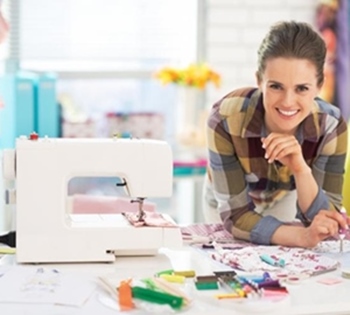 When Issac Merritt Singer patented the very first sewing machine in 1851, it revolutionized the world. Now you have decided to follow in the footsteps of millions of people who’ve come before and take up the noble pursuit of sewing with one of these machines. As a beginner, you might feel lost, not knowing which features you will need or use in a machine. Luckily, in spite of all the new bells and whistles available, the essence of the sewing machines hasn’t changed all that much since the mid-19th century. But as a beginner, in this case, you have a number of considerations to take into account.
When Issac Merritt Singer patented the very first sewing machine in 1851, it revolutionized the world. Now you have decided to follow in the footsteps of millions of people who’ve come before and take up the noble pursuit of sewing with one of these machines. As a beginner, you might feel lost, not knowing which features you will need or use in a machine. Luckily, in spite of all the new bells and whistles available, the essence of the sewing machines hasn’t changed all that much since the mid-19th century. But as a beginner, in this case, you have a number of considerations to take into account.
1. Mobility
In terms of portability, many machines these days are small and lightweight enough to travel. However, while moving it about the house is practical, sewing machines and being a nomad two difficult things to accomplish at the same time.
Always treat it as gently as you would treat a crate of eggs, and also keep in mind the power supply requirements for your area, as many of the models in our guide are designed only for use in North America. The delicacy of inner workings might mean that even the journey from the manufacturer can hurt its functionality – rarely but it still can happen. Luckily, you are covered by a warranty.
Some machines are more portable than others. Logically, beginner sewing machines with limited functionalities prove to be more portable than the industrial type sewing machines.
But if you want to carry your unit even in your bag, you can check our mini sewing machine reviews.
2. Machine Type
Should you get a mechanical or an electronic sewing machine? Even with all the new digitalized machines on the market, it is always good to have a basic mechanical machine. Computerized machines often require more skill and sometimes they even break faster. As you can see from our computerized sewing machine reviews, they are more complex and there is more room for error, so for a beginner, this means there is more that can go wrong. We recommend waiting until you have a basic command of sewing machine functions before tackling computerized machines.
3. Stitching Options
How do you know which of this myriad of stitching configurations to choose, and for what purpose? Although it’s important to have an adjustable stitch length, the number of stitching configurations you need is relatively simple. Many professionals can get by easily with a simple straight stitch and a zig-zag. A zig-zag is better for knit or stretchy fabrics.
4. Embroidering
Keep in mind that embroidery is another thing altogether. Some machines do programmable embroidery, but unless you intend to make this the focus of your sewing projects, a machine with too many features may simply add extra complications to your learning.
5. Presser Feet
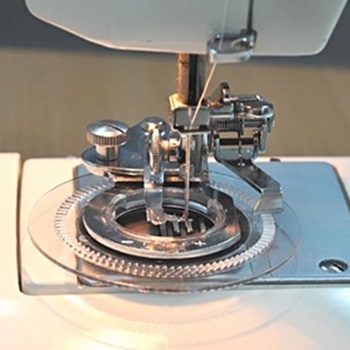 When it comes to which presser feet it should have, most machines come with a basic selection. These are mounted right next to the needle and hold the fabric where it is being sewn. Although you can buy them separately, it’s good to start out with a supply of basic presser feet.
When it comes to which presser feet it should have, most machines come with a basic selection. These are mounted right next to the needle and hold the fabric where it is being sewn. Although you can buy them separately, it’s good to start out with a supply of basic presser feet.
You often find that new machines will include several of the following types of presser feet: a general sewing foot for straight stitches, a foot for zig-zag stitching, one for buttonholes – a separate one for buttons, and a zipper foot. These attach differently on many machines. The simplest presser feet can simply snap-on, but even the rest of them are generally not too difficult to master and install.
6. Free Arm
A free arm option in sewing is always a good idea. This basically means a large flat section of the lower part of the machine is removable, leaving an extended narrow surface next to the needle, making it easier to sew on a curve. It’s almost essential for sleeves and shirt cuffs, while it also makes hemming trousers much easier. Without one, you have to struggle to keep your cuff or trouser hem fed straight through the needle, while at the same time keeping the rest of the fabric out and away so that it doesn’t get caught underneath and end up sewn to itself.
An automated needle-threader saves a lot of time and effort, even if you have excellent sight and coordination.
7. Machine Strength
Different machines have different motor strength. Although a stronger motor might mean a heavier machine, it is necessary if you intend to work with dense fabrics, such as denim, hides, or upholstery. Consider the range of projects you might want to try in the future. If they involve sewing through many layers of thick fabrics, consider a more heavy-duty model.
8. Machine Speed
Another aspect to look at is the speed adjustment option. As in a car, the speed of your needle is controlled by the weight of your foot on the pedal. But many basic machines today have a feature to control the maximum speed. This is good not only for beginners but also for preventing accidents when working with delicate or very heavy fabrics.
9. The Cost
Think about your budget. Research current going prices of each type of machine before settling on one. You often get what you pay for, and a sturdy machine with a metal frame is going to cost a bit more than a cheaper plastic one.
10. Motivation
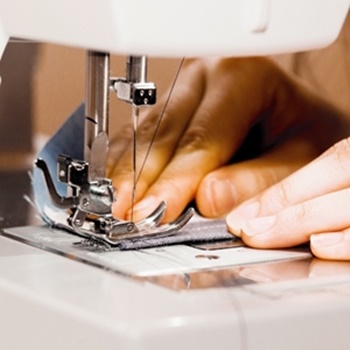 Your motivation for learning to sew should also play into what you want in a sewing machine. For example, if you want it for quilting or for sewing denim jeans, you might need something more heavy-duty, which can handle thick fabrics, or multiple layers of fabric at once (although you’ll still need different needles for each, and it’s good to have a stock of them if you plan on this).
Your motivation for learning to sew should also play into what you want in a sewing machine. For example, if you want it for quilting or for sewing denim jeans, you might need something more heavy-duty, which can handle thick fabrics, or multiple layers of fabric at once (although you’ll still need different needles for each, and it’s good to have a stock of them if you plan on this).
Keep in mind the more features you want, the more complex your machine will be. However, some of the most basic, simple machines still come with a free arm and a few decorative stitches.
11. Parts and Supplies
Make sure that you only use the exact parts intended for use with your specific machine. This particularly includes bobbins, which can be very finicky when you are starting out. They tangle their thread into birds’ nests with little provocation. Thread entanglement can also be prevented with bobbin spacers (which are not always included). Pay attention to bobbin size and tension settings carefully. If you still have a problem with thread entanglement, your machine may have a timing issue between the top and bottom shafts. This requires a professional to repair it.
Additionally, you will also need to have a few essential sewing supplies. Think your grandmother’s sewing box: various threads (cotton versus synthetic or stronger quilting thread), thread scissors (generally daintier than typical shears), a seam ripper for undoing mistakes, and straight pins for holding your patterns and fabric in place.
FAQ About Basic Sewing Machines
1. What do I do with the machine if I don’t like sewing at all? Can I sell it without a big loss?
Absolutely! If you think that you can’t master the art of sewing and that it’s not for you, you can always resell the machine without a big loss. Many others will be happy to snag a deal for the barely used sewing machine.
You can also gift it to someone if you know they need it. If you have purchase protection, some manufacturers allow you to return the product, usually after 30 days, free of charge.
2. Where can I try out different sewing machines?
In case you didn’t know, you don’t have to go blind when choosing the beginner sewing machine. Look for beginner courses around you, and go to a class. Ask the instructor for advice, or the students. They will usually have their own machines with them, so you can try out different models on the spot.
3. How often should my sewing machine require maintenance?
This question depends very much on how often you use it, and what sort of fabrics and thread you use with it. Some fabrics can produce more lint, which builds up in the machine’s gears and hinders performance. It’s important to clean and oil your machine periodically. With this in mind, some of the newer models are self-lubricating and require very little attention.
Repairing machines under warranty can be a hassle, as you either have to suffer the expense and packing woes to ship it back to the manufacturer (and the risk of having it damaged in transit), or take it to an authorized repair place, which may not even be within a reasonable driving distance. Local but unauthorized machine repair may be more practical, but beware – it can void your warranty. Make sure to always select a machine with a good warranty and customer support.
4. Why does my needle keep breaking?
Needles will break if you are pulling the fabric through too much. They will also break if they are dull, inappropriate for the material you are using, or the incorrect type for the machine. Make sure you have the correct needles for the machine you are using. Thicker fabrics, especially hide, like fur or leather, require special needles that are not always included as standard equipment (but which can be purchased separately).
It is also important to periodically change out your needles, as they get dull after a while, and this can damage the fabric or cause problems. Needles can also become bent, which will cause them to sew very badly, if at all, and to possibly cause damage to the machine itself. Always make sure your needles are in good condition.
Wrap Up
Choosing the right sewing machine to begin learning with can be tricky when there are so many options on modern machines today. Buying a wrong unit, or an overcomplicated one can easily make you give up this amazingly creative hobby. We hope that our guide to the best sewing machine for beginners has provided clarification and insight to help you make an informed decision.
Our goal is to offer you the knowledge and help you understand your needs so that you can buy the best basic sewing machine for you. If there’s a chance we missed something in our guide, feel free to write us in the comments below and we will respond as soon as possible. Happy sewing!





